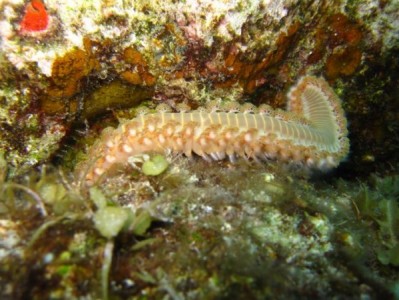- Name:
Common Bristle Worm
(View AKA's) - Family: Amphinomidae
- Species: Worms
- Scientific Name: Polychaeta


General info about Common Bristle Worm
The Bristle Worm has a tail and a segmented body, and typically each body segment has a pair of leg-like parapodia with spiny hairs on the sides called bristles that sticking out. These little hairs or bristles give the worms it's named. The word Polychaete is Greek and means "with much hair." While there are over 10,000 different worms that are considered “bristle worm” there are two different types of worms that we are concerned with and that is if it is "Reef Safe" or "Not Reef Safe".
The Common Bristle Worm is Reef Safe and is a good invertebrate to have in your tank and can serve as a good cleaner crew. They normally have a pink or gray body and pose no harm to anything in your tank. With that said you try to handle them or try to remove them from your tank you should wear gloves. The bristles on the Common Bristle Worm, are designed to protect it and release when they puncture whatever is trying to gram them. Think of them like them as a porcupine of the ocean. There are mostly there to defend itself.
Bristle Worms are nocturnal most aquariums have them and you may never see them unless you look for them at night. If they come out during the day it is typically because they are starving and feel like there is no risk for them. Late at night after the lights have been out for some time, you can use a red flashlight (they typically do not respond to the red light) and you will see the nightlife of your tank which will normally include several worms as well.
In some cases, Common Bristle Worms can quickly multiply if you are overfeeding your tank. The Common Bristle Worm is a scavenger feeder that will eat leftover food or decaying proteins in your tank. If you feel like there are too many you may want to consider adding a wrasse fish to your tank. Wrasse's stay very active in your tank and are known to constantly hunt down small invertebrates and worms in your tank.
Common Bristle Worm Diet & Nutrition
Bristle Worms are a bottom-feeding scavenger and will eat different types of detritus as well as algae, uneaten fish food and even fish waste. The Bristle Worms are able to reach the tough to reach places that most species have a hard time getting to like tiny pores/holes, and cracks in your rock. If you do not have any worms to get this food then it will rot and cause water quality issues over time.
Caution with Common Bristle Worm
Handle with care and always ware gloved if you plan to handle Bristle Worms, their bristles can release into your skin and can cause skin irritation.
Original Detail
| Name | Species | Family | Scientific Name | More Detail | Added by |
|---|---|---|---|---|---|
| Common Bristle Worm | Worms | Amphinomidae | Polychaeta | The Bristle Worm has a tail and a segmented body, and typically each body segment has a pair of leg-like parapodia with spiny hairs on the sides called bristles that sticking out. These little hairs or bristles give the worms it's named. The word Polychaete is Greek and means "with much hair." While there are over 10,000 different worms that are considered “bristle worm” there are two different types of worms that we are concerned with and that is if it is "Reef Safe" or "Not Reef Safe". The Common Bristle Worm is Reef Safe and is a good invertebrate to have in your tank and can serve as a good cleaner crew. They normally have a pink or gray body and pose no harm to anything in your tank. With that said you try to handle them or try to remove them from your tank you should wear gloves. The bristles on the Common Bristle Worm, are designed to protect it and release when they puncture whatever is trying to gram them. Think of them like them as a porcupine of the ocean. There are mostly there to defend itself. Bristle Worms are nocturnal most aquariums have them and you may never see them unless you look for them at night. If they come out during the day it is typically because they are starving and feel like there is no risk for them. Late at night after the lights have been out for some time, you can use a red flashlight (they typically do not respond to the red light) and you will see the nightlife of your tank which will normally include several worms as well. In some cases, Common Bristle Worms can quickly multiply if you are overfeeding your tank. The Common Bristle Worm is a scavenger feeder that will eat leftover food or decaying proteins in your tank. If you feel like there are too many you may want to consider adding a wrasse fish to your tank. Wrasse's stay very active in your tank and are known to constantly hunt down small invertebrates and worms in your tank. |
PalaciosAn |
Changed by users
| Submitted Date | Submitted By | Status | Action |
|---|

